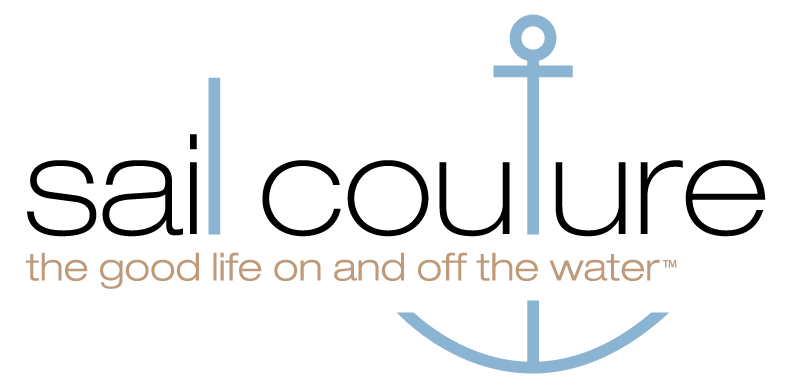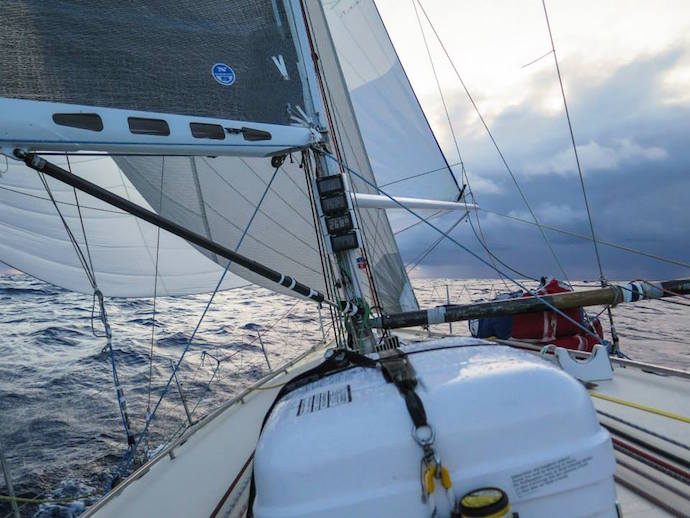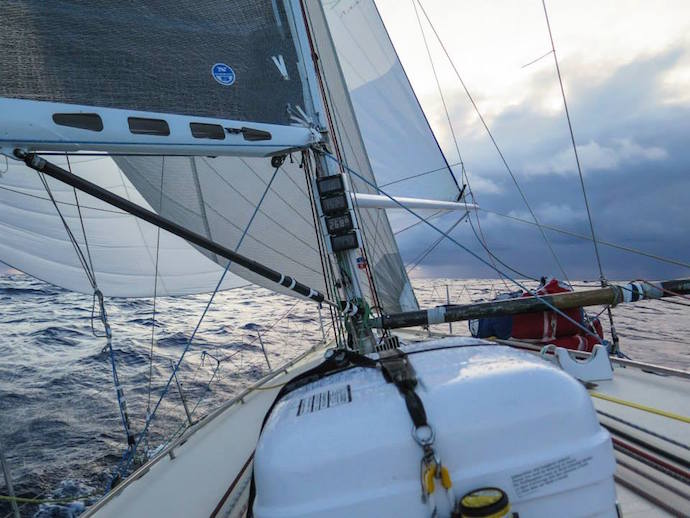San Francisco sailor Jenn Virskus shares her experience of racing the 2015 Transpac aboard the Santa Cruz 50 Adrenalin.
I flew into Long Beach the night before my first Transpac and the power was out. After ordering fajitas, guacamole, and a beer at a hole-in-the-wall Mexican joint, I turned to the two crewmates I was eating with and said, “I’m not gonna lie, I’m a little bit scared.” Joseph Shacat high-fived me.
Co-skipper Del Olsen and medic Gail Yando, two of the more experienced ocean racers. Photo: Jenn Virskus.
The reality of Adrenalin (Santa Cruz 50) was, we were eight people, eight pretty good sailors, with almost no ocean experience between us. Gail Yando had done the most Pacific crossings at four, but none were the Transpac, and only one was a race. Del Olsen had done the same race, his only ocean crossing, and Andy Bates had done a single ocean cruising crossing. The rest of us were complete rookies, including our navigator Kirk Twardowski, who had very little big boat experience at all.
The boat was in excellent condition, Del and Greg Mitchell especially saw to that. The rest of us helped—I assisted with the laying of the carbon fiber into the mold for the new emergency rudder and John Clark and I both helped out with vacuum-packing spinnakers and repairing the tired #1 while Kirk spent six months with his head buried in a computer learning the navigation programs, but I think everyone agrees the boat prep was mostly Del and Greg.
Gail had prepared home-cooked, vacuum-sealed frozen meals for up to 12 days, there was a supply of Ramen that would last several more days if necessary, and the watermaker made better tasting water than in many homes in the Bay Area. We had two GPS tracking units, the official Yellow Brick race tracker and a second unit with which we could post status updates to Facebook. Our cell phones wouldn’t work, but we weren’t going to be disconnected, not really. So, what was there to be afraid of?
It was more of a fear of the unknown than the sailing. I was coming off the Mac race, which I would argue is more like a middle distance race than a marathon where the pace and intensity is much higher. While no one besides Joseph admitted it to me, I think everyone was a little jittery that Thursday morning.
The weather forecast was showing our start to be right and as we went off the line we had a comfortable 10 – 12 knots. We immediately took a flyer up the coast while the fleet took a left and went straight toward Catalina—we had “local knowledge” that we can now admit didn’t pay off. But we did make Catalina and not quite last.
Gail made fettuccine alfredo for dinner and as the sun fell the sky was clear yielding a heap of stars. It wasn’t as cold as on Lake Michigan, but we were all mostly bundled up. On the horizon, a dark bank of clouds awaited us.
The first night had us spinning every which way. The wind was all over the place and dropped to as little as a knot. Our goal was to just keep the boat moving in any direction we could. At one point we were heading toward Cabo. By Friday afternoon we were heading toward the Farallones.
By Saturday the wind had settled and we’d followed most of the fleet on a northerly course. Kirk didn’t share his big picture planning with the rest of us too much, if at all. We were given a course and a true wind direction to sail to, and that’s what we did. Once we settled into the routine, the days began to pass quickly. Three hours on, three hours off. Six hours off to sleep during the day.
What did we see? Water. A few dolphins, phosphorescents at night, flying fish (they actually look like little Cessnas) and a few flying squid, and a lot of plastic. There was no mistaking when we hit a piece under the water; the whole boat would vibrate, DONG!!!!! It was unnerving.
“For most of the race, it was the only thing we could see, no moon, no stars, just red numbers.” Photo: Jenn Virskus.
What did we do? We sailed. We built up “Barka loungers” to trim the kite. We ate, a lot. We stared for hours at the water. At night we stared at red numbers on the mast. For most of the race, it was the only thing we could see. No moon, no stars, just red numbers.
What did we talk about? The wind—where it was coming from, when it would shift. And we took bets on when we’d actually finish. I hoped for a sunset finish on Tuesday the 28th, at approximately 21:15:15 boat time. Cynical John put our arrival time down as Thursday the 30th at 04:00, but there were times when we all thought he could be right.
To soothe our frustration, we started a band. Or at least, we came up with the name for the band, Kamikaze Fish. It would be an early 2000s neo-punk boat band and a list of “hit songs” for our first album included “Waiting for a Header,” “Suck You, Squally,” “Stinky Socks,” “Deckman” (the name of our navigation system), and “Squid At My Feet.”
And then we were there. With about 30 miles to go, we could see the shadow of both Molokai and Oahu. There was spaghetti we could have had for dinner, but it was hot and sticky and no one wanted Gail to turn the stove on, so Del made bowls of Raman with hot tap water. When dusk fell, no one had the energy or the motivation to take a picture of our final sunset. Oahu didn’t get big enough in front of us to take a picture until after dark.
The boat was mostly quiet as we crossed the Kaiwi Channel. The lights of Koko Head and the glow of Waikiki were a strange sight after so many nights with nothing on the horizon. The Red #2 buoy was hard to spot at first, but once we found it, were deadlocked on. Kirk turned the radio up for the finish. I think the race committee boat sounded a horn, but what we heard was, “Adrenalin, this is the Transpac race committee. Congratulations and welcome to Hawaii!”
The finish was otherwise anti-climatic. There were a few high-fives, a few hugs, but mostly, it was back to work. We had to get the sails down and dig out the fenders.
We had to collect our stuff, some of us (no names mentioned), from all areas of the boat and even other people’s bags. The decks at the Hawaii Yacht Club were full as we pulled in and I thought that was where we were going. But then we looked across the harbor and I saw my mom waving frantically from the dock with her camera up and wearing a funny pointed hat.
The Adrenalin crew in Aloha shirts, from left to right: John Clark, Gail Yando, Del Olsen, Kirk Twardowski, Jenn Virskus, Greg Mitchell, Andy Bates, Joseph Shacat. Photo: Cathy Virskus.
And grass skirts of course! From left to right: Joseph Shacat, Jenn Virskus, Andy Bates, Greg Mitchell, Del Olsen, Gail Yando, John Clark, Kirk Twardowski. Photo: Cathy Virskus.
After the inspection, we put on our Aloha shirts. There were leis and Mai Tais, poke and grilled meat on skewers. We were made to wear hula skirts and dance, and there were a lot of pictures, which is a good thing now because it’s all a blur, and that’s not the rum talking.
A race like this, it’s not something that can be captured. We wrote a boat log when we could, and we made some videos, but even looking at those now, it’s almost like stepping outside of yourself. Sharing stories on the dock, you realize that everyone on the boat had a different experience, a singular experience, and it can’t ever be repeated. You want to know what the Transpac was like? The next one sets sail from Long Beach in July 2019!
Jenn Virskus is a writer, skier, sailor, adventurer, photographer, cat lover, stuff doer, not necessarily in that order! See more of her writing on her website https://jenn.virskus.com/.
If you enjoyed this article you may also like What It’s Like to Sail One of the World’s Fastest Yachts and Baja Ha-Ha Cruise Rally Report.























